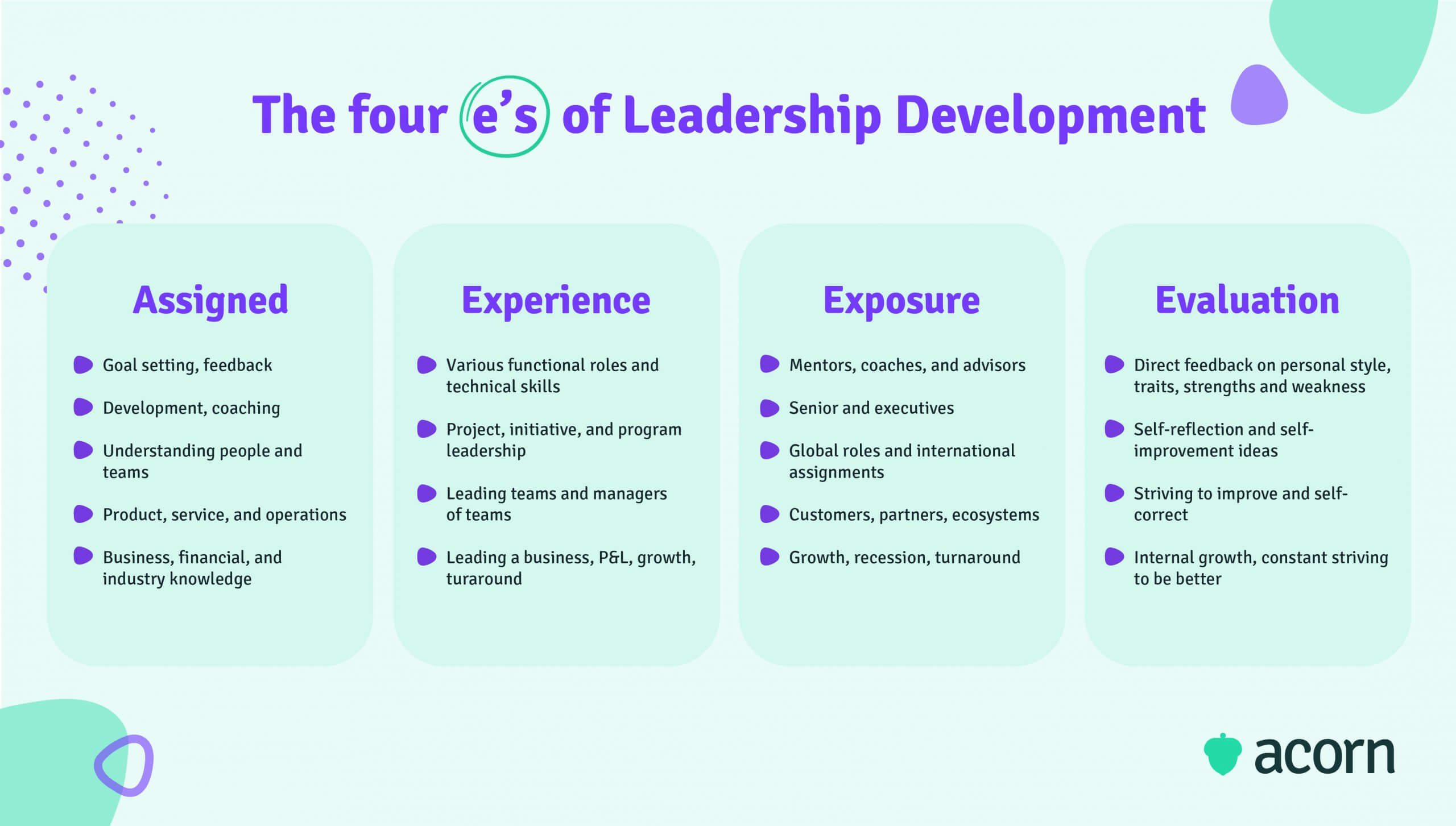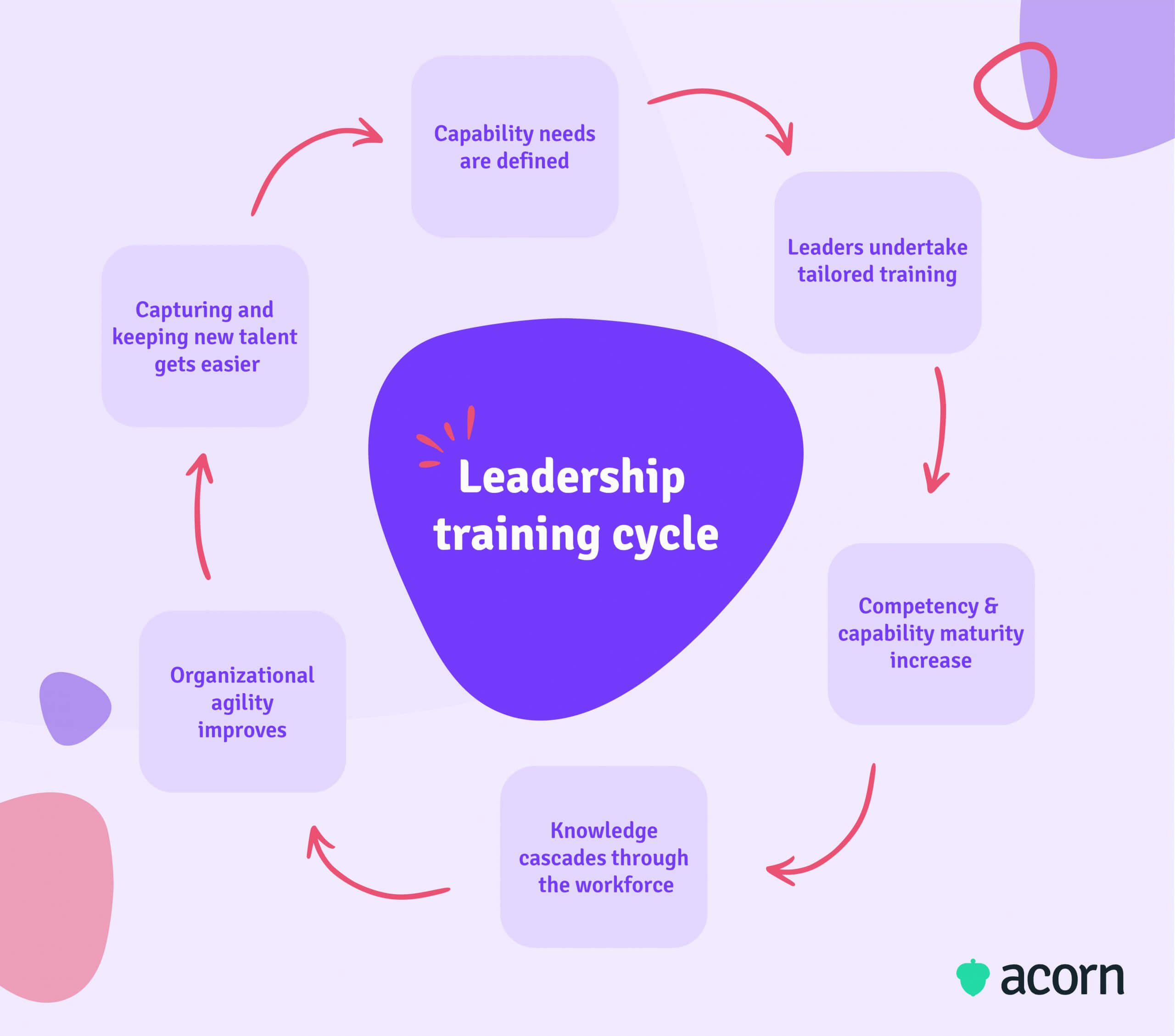The Value of Leadership Development and How to Create a Successful Leadership Program
Reading Time:

Lead the pack with the latest in strategic L&D every month— straight to your inbox.
SubscribeLeaders drive the strategic ship that is your business. Their ongoing development is perhaps one of the most important investments you can make.
Small, large, or somewhere in between, your organisation is going to have one thing for sure: Leaders. Companies are seeing programs that develop leadership capabilities as a good investment for the future, meaning the leadership development industry is now booming. And while you can always hire someone to take on a leadership role when a position becomes vacant, it’s more beneficial to you and your business to develop leaders from within your company.
In this article we’ll dive into what leadership development can do for your organisation, and the basics of how to create one.
What is leadership development?
Leadership development is a strategic process designed to help employees develop their leadership skills and competencies in order to prepare them for management and leadership roles within the organisation. Leadership development programs are usually structured and tailored to the unique needs of the individual employee and the organisation as a whole.
Why is leadership development important?
What value does leadership development bring to your business? It goes without saying that your organisation will function more effectively with leaders in its ranks. On top of that, it’s so much easier to grow your leadership talent from within rather than finding someone externally who will have to take time to learn the inner workings of your company.
At a broader level, what it really means is improved business performance. That might seem like a difficult thing to measure in terms of your leadership development, but that’s why here at Acorn, we’ve pioneered the first performance learning management system (PLMS). It’s a dynamic AI-powered platform designed to synchronise L&D experiences with organisational performance.
Let’s take a look in more detail at the factors that make leadership development important to your organisation’s success.

Attract and retain talent
These days, job-hopping for the best deal is more common than ever. People prefer to work for companies that offer professional development programs. Ergo, you can make your business the best deal by offering some form of career progression. Not only will it be easier to attract new talent, but they’ll be more likely to stay knowing that they’ll have the opportunity to develop leadership skills.
In essence, a leadership development program (LDP) is designed to help the next generation of employees gain new skill sets and push them into more senior positions within your organisation, where they can put their new skills and expertise to work.
Improve financial performance
It’s no secret that if you retain talent, you save on costs. Leadership development initiatives increase employee engagement, and when your talent stays, you spend less on recruitment and onboarding. Plus, engaged employees lead to better productivity, and that will also help to lower your costs.
Of course, your hard-working workforce can still be affected by unexpected challenges. The good news is an LDP ensures there are more people within your organisation who have the leadership capability to counter those issues as they arise, again saving you money.
Drive strategy
An effective leadership strategy is aligned closely with business strategy. When you develop leaders, they’ll have the ability drive your organisation’s strategy execution. With an LDP you’ll have more employees outside of management with leadership capabilities navigating change and stepping up to any challenges your business faces. Plus, a future leader will be able to direct a team of workers to meet business goals successfully.
Increase productivity
Driving employee engagement with an LDP leads to increased productivity and focus in the workplace. It’ll increase motivation among your staff and encourage them to motivate others to do the same. The bottom line: Having a productive workforce that is engaged in their work is only going to increase business success.
Train future leaders
If you use your leadership development correctly, you’ll have unlimited access to potential leaders who can take up vacant positions. It follows:
- Leadership development programs give you employees the capacity to become senior leaders.
- Developing leadership skills becomes commonplace in the workplace, meaning employees begin to learn by osmosis.
- Not only is talent development secure, but it’s now a key driver for succession planning.
Culture
Leadership development isn’t just about developing the capabilities that make great leaders, but fostering behavioural change that builds a positive workplace culture. We all know how culture affects the workplace, especially bad workplace cultures. But with the right kind of leadership development you can foster a culture of inclusivity and productivity that will help your organisation engage employees and retain talent.
What is a leadership development program?
To reap the benefits of leadership development in your organisation, you’re going to need to use a leadership development program.
Leadership development programs are the structured plans made to help your employees develop the critical skills they require for success in their careers by providing the necessary guidance and knowledge. The idea is to foster leadership capabilities in program participants so that they can progress through your organisation.
Why leadership development programs fail
But while LDPs are made to build the future leaders of your workforce, many of them fail at the first hurdle.
Most organisations today lack the structured hierarchy of positions that they had in the past. Leadership development efforts are now longer centred around the C-suite (that is, the senior executives of your company). Ergo, your traditional LDPs—which were built to progress your talent up the hierarchy into senior roles—are no longer the cutting edge of leadership training.
Josh Bersin talks a little on how traditional leadership development programs are lacking in the current climate. Organisations just don’t need to have a set group of leaders anymore. The types of skills leaders have traditionally needed are no longer the only skills leaders require. And while in the past LDPs have focused mainly on leader-specific skills like strategy development and analysis, these days soft skills are in-demand for leaders too.
This isn’t to say you don’t need leaders. The point is those leadership roles need to be more dynamic than static.
What is the effect of a bad leadership development program?
Well, we’ve talked about the benefits of leadership development, but what happens if you do it badly or not at all?
For starters, poor leadership is not going to help your organisation attract and retain talent. Employees won’t want to stick around if their boss lacks the capacity to be a good leader, thus increasing your turnover rate (and the cost it takes to remedy that). In fact, 50% of employees quit their jobs over examples of poor leadership.
You also need to consider the effect bad leadership development has on the productivity of your workforce. Without a capable and effective leader to motivate them, your employees’ productivity will decline, affecting your bottom line.
A crucial part of a leader’s job is to ensure that the organisation’s demand strategy is being met. If the individuals you have in leadership roles haven’t been developed properly, they won’t know how to direct team members in a way that takes the organisation one step closer to achieving its goals. And without an active and effective strategy towards meeting priorities, your business will fall short.
What are the essential components of a leadership development program?
As with any program designed to enhance your workforce or deliver on targets, it’s crucial that you create a leadership development program that is unique to your organisation and its needs. But that doesn’t mean there aren’t essential building blocks that fit all businesses and strengthen the creation of an effective LDP.

Coaching and training
Beginning your learning in leadership can be overwhelming for anybody, which is why it’s important you provide coaching for employees as part of their leadership development program.
We don’t just mean sitting your employee in front of online courses and letting them learn everything they need for the role that way. Theory is helpful, but practical mentoring is what will really cement leadership concepts in the minds of your learners. Your employees will benefit from having a coach who can give them perspective on the leadership roles and what they entail.
Milestones, goals, and achievements
Before you start putting your employees through an LDP, you need to define what goals you want met. This also includes milestones for your employees to reach as they progress through their leadership development. Setting goals and milestones for your leadership programs is important for two reasons:
- They show what your expectations are for the program.
- They provide your employees with objectives to meet, thus keeping them on track.
You need to make these expectations clear to your employees if you want them to be motivated to continue their training. At the same time, if your expectations are too hard or too easy to meet, your employees will lack interest in their learning.
And don’t think you can limit your goal-setting to your LDP. Given your objective is to build the leaders of the future, you’ll need to consider what capabilities leaders will need in the future. It’s just another aspect of workforce planning that will help you build a strong and competitive workforce. And, just like workforce planning, it’s an ongoing process. You’re going to need continuous leadership development using a dynamic process to meet new goals as the industry changes over time.
Accountability
Leadership is not about micromanaging. The leaders of tomorrow need to know how to hold themselves and the people on their team accountable for their responsibilities and actions, meaning everybody is responsible for completing their own work. Obviously, you don’t want anyone to feel that they can’t think outside the box because they have to diligently finish their tasks. But you do want your leaders to embody the balancing act between responsibility and innovation, fostering a workplace culture that holds those values dear.
Communication
One of the most important tools in a leader’s arsenal are their soft skills. A leader needs the ability to influence and communicate with their team if they want them to be effective and meet project targets in a timely manner. If a leader lacks effective communication skills, their team is going to have a hard time understanding what’s expected of them, what their focus should be, and how they’re expected to go about it.
Support
When it comes to developing the next generation of leaders for your company, employees in current leadership positions shouldn’t be left out of the process. Outside of coaching, your current leaders should be involved to provide support to employees who are developing their leadership capability.
Employees are more likely to be motivated to complete their learning if they know they have the support of their boss or supervisor. If people aren’t supportive of our learning, it can feel like fighting an uphill battle. But if we have our bosses on our side, we become engaged in the workforce and the process of learning suddenly becomes so much more efficient and effective.
Key takeaways
Leadership development is just one aspect of change management that can really help your organisation prepare for the future. Not only will your business be future-ready with new leaders trained in critical capabilities needed in advance, but you’ll be meeting your organisational goals and increasing productivity along the way.